by Glen Springer | Apr 30, 2012
So now you that you have purchased a marketing automation platform you are ready to implement and it’s not as simple as you were led to believe. As an outsourced sales and marketing company we have already helped to implement several platforms (as well as implementing our own) and helped companies with several stalled implementations. Here are some best practices in marketing and sales automation because, as one vendor recently told us, ‘we can sell them the car but we can’t drive it for them’. Here are some basic tips and some best practices to help you avoid some headaches and to learn from our mistakes and success. If you have not checked out what these platforms can do here is a quick overview from Pardot 5 Minute Overview of Marketing Automation and this post will make a whole lot more sense.
Think about your Content in a Different Way – The whole point of a marketing automation platform is to drive more business in a more effective way. This starts with how you are speaking with your buyer. If your content is still all about your product – tech sheets, features and benefits etc. its -time to think about being customer centric rather than product centric.” Your drip campaigns will drive more business if you talk to your customers about their problems and their needs. You may need to look at the “voice” of your messages and refine your language a bit. As a starting point look at how may time you talk about “Our’ product, “our” team vs. “your” needs, “your” business and “your” customers. Stop being product centric and start being customer centric. Here is a series of blogs on how to shift your content approach and get sales and marketing on the same page.
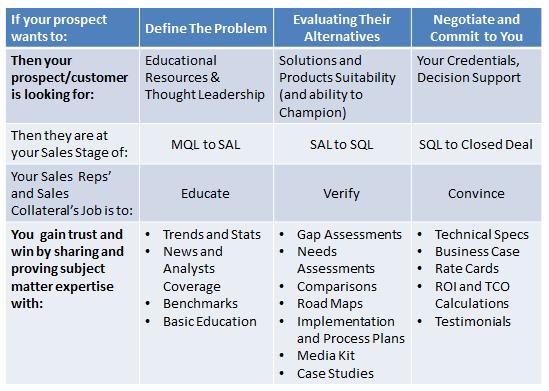
Organize your Content Ahead of Time. For a marketing automation platform to run effectively it helps to do two things with your content. First you should isolate all your webcasts, white papers, blogs, videos on individual website pages. This allows you to easily understand what your customer specifics needs are which in turn allows you to score your leads more effectively as you track their digital interest. Secondly, it really helps to also create landing pages that offers your customer content for all three stages of their buying cycle so you can track when your buyers are moving from educating themselves (kicking the tires) to being ready to buy (e.g looking at pricing or testimonials). Gabriel Sales has created an easy to use sales content management technology – Gabriel Sales Digital Base Camp™ that can help you do this in a matter of weeks. Below is an example of one of those lead scoring features.
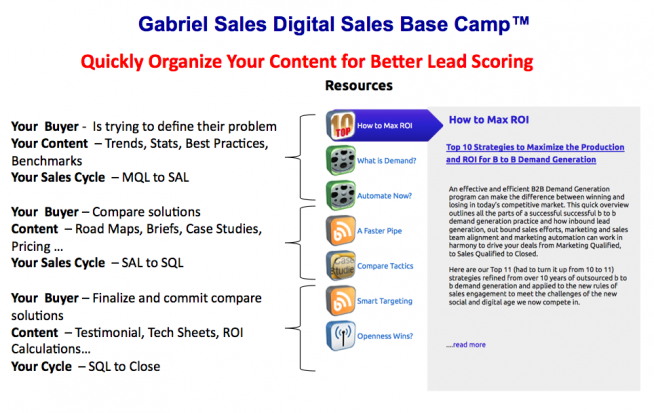
Involve Sales and Invest the Time Integrating with your CRM – What we have found is that even a basic integration can take an IT professional too much time. Most of the marketing automation platforms we have seen have huge volume of really cool features and bells and whistles so you can tend to over design before you know how you want to use them. Ultimately this is about empowering your sales team and recognizing your IT teams expertise is not sales. Probably one of the biggest bottle necks we have seen is that IT folks get proprietary and a project that they thought would take weeks can take a developer three months or more . The challenges are not with the system’s API or stability; they were with our client’s requirements, process definitions and prioritization. Like most development work that starts “easy” it quickly gets complex when they don’t understand the underlying business processes. Unfortunately as the time line expands it ends up being sales and marketing that are on the hook for results and not the developers. Salesforce.com has been the easiest integration for all the platforms we have seen.
Keep your Initial Drip Campaigns Simple. This is probably one of the biggest lessons we learned. When we first started we came up with a very complex IF/ then workflow so if they opened this piece of content on a topic area we would send them another piece of content on topic area B and then if they didn’t open that we would send them content Z. It was too much and just writing about it confuses me. What we found is about 80% of the value you are going to get from your initial drip campaigns is going to come from simply implementing them. It takes time to learn a new software and the biggest value the software provided initially is simply keeping your brand and solution in front of your buyers over time so your reps don’t have to. A simple five to seven touch campaign without any IF/then work flows was enough to get more deals flowing at less cost. Don’t frustrate yourself. You will quickly learn from your wins. If you are a smaller company, as a best practice, we recommend that you start by talking to your sales reps about their sales process and simply take that sales process map and create your initial drip campaigns for about three target markets.
Tap your vendors (and other vendors) knowledge centers – This industry is not that old. Eloqua, Pardot and Marketo (to name a few) all have fantastic knowledge centers that can teach you the basics of lead scoring and nurturing etc. Our vendor Pardot has been a huge help but we have also found both Marketo and Eloqua’s knowledge centers to be valuable as well. Obviously as an outsourced sales and marketing company we also recommend that you strongly consider working with an organization like ours. We have the advantage of having worked in the space across multiple enterprises so we have made a great deal of the mistakes already so you don’t need to.
We hope this blog has been helpful. Marketing Automation is a relatively new concept for most marketing teams and we have found that once you start to gain some momentum you will quickly realize that it’s clearly how business will be done for the next decade. We are just at the beginning of a new paradigm starting with marketing automation and then, as we are quickly discovering, if your marketing automation implementation is done correctly this will drift towards sales automation. Ultimately this will begin to drive more deals fast at less cost. We are experiencing some fantastic initial success reducing cost of sales percentages for both ourselves and our clients. The learning curve is exponential. So have fun.
If you have not checked out what these platforms can do here is a quick overview from Pardot 5 Minute Overview of Marketing Automation. If you have a stalled with your marketing automation implementation or if you would like to know more about best practices in marketing and sales automation, feel free to contact us for a quick consultative call.
by Glen Springer | Apr 30, 2012
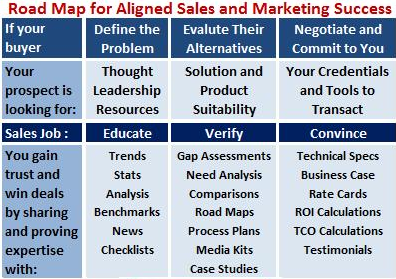
So now you that you have purchased a marketing automation platform you are ready to implement and it’s not as simple as you were led to believe. As an outsourced sales and marketing company we have already helped to implement several platforms (as well as implementing our own) and helped companies with several stalled implementations. Here are some best practices in marketing and sales automation because, as one vendor recently told us, ‘we can sell them the car but we can’t drive it for them’. Here are some basic tips and some best practices to help you avoid some headaches and to learn from our mistakes and success. If you have not checked out what these platforms can do here is a quick overview from Pardot 5 Minute Overview of Marketing Automation and this post will make a whole lot more sense.
Think about your Content in a Different Way
The whole point of a marketing automation platform is to drive more business in a more effective way. This starts with how you are speaking with your buyer. If your content is still all about your product – tech sheets, features and benefits etc. its -time to think about being customer centric rather than product centric.” Your drip campaigns will drive more business if you talk to your customers about their problems and their needs. You may need to look at the “voice” of your messages and refine your language a bit. As a starting point look at how may time you talk about “Our’ product, “our” team vs. “your” needs, “your” business and “your” customers. Stop being product centric and start being customer centric. Here is a series of blogs on how to shift your content approach and get sales and marketing on the same page.
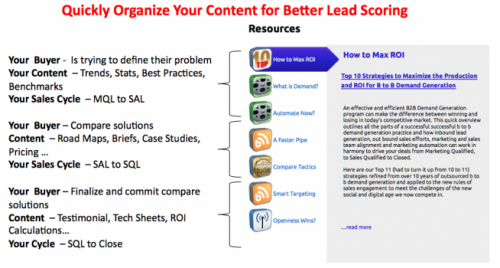 Organize your Content Ahead of Time
Organize your Content Ahead of Time
For a marketing automation platform to run effectively it helps to do two things with your content. First you should isolate all your webcasts, white papers, blogs, videos on individual website pages. This allows you to easily understand what your customer specifics needs are which in turn allows you to score your leads more effectively as you track their digital interest. Secondly, it really helps to also create landing pages that offers your customer content for all three stages of their buying cycle so you can track when your buyers are moving from educating themselves (kicking the tires) to being ready to buy (e.g looking at pricing or testimonials). Gabriel Sales has created an easy to use sales content management technology – Gabriel Sales Digital Demand Center™ that can help you do this in a matter of weeks. The image on the right is an example of one of those lead scoring features.
Involve Sales and Invest the Time Integrating with your CRM
What we have found is that even a basic integration can take an IT professional too much time. Most of the marketing automation platforms we have seen have huge volume of really cool features and bells and whistles so you can tend to over design before you know how you want to use them. Ultimately this is about empowering your sales team and recognizing your IT teams expertise is not sales. Probably one of the biggest bottle necks we have seen is that IT folks get proprietary and a project that they thought would take weeks can take a developer three months or more . The challenges are not with the system’s API or stability; they were with our client’s requirements, process definitions and prioritization. Like most development work that starts “easy” it quickly gets complex when they don’t understand the underlying business processes. Unfortunately as the time line expands it ends up being sales and marketing that are on the hook for results and not the developers. Salesforce.com has been the easiest integration for all the platforms we have seen.
Keep your Initial Drip Campaigns Simple
This is probably one of the biggest lessons we learned. When we first started we came up with a very complex IF/ then workflow so if they opened this piece of content on a topic area we would send them another piece of content on topic area B and then if they didn’t open that we would send them content Z. It was too much and just writing about it confuses me. What we found is about 80% of the value you are going to get from your initial drip campaigns is going to come from simply implementing them. It takes time to learn a new software and the biggest value the software provided initially is simply keeping your brand and solution in front of your buyers over time so your reps don’t have to. A simple five to seven touch campaign without any IF/then work flows was enough to get more deals flowing at less cost. Don’t frustrate yourself. You will quickly learn from your wins. If you are a smaller company, as a best practice, we recommend that you start by talking to your sales reps about their sales process and simply take that sales process map and create your initial drip campaigns for about three target markets.
Tap your vendors (and other vendors) knowledge centers
This industry is not that old. Eloqua, Pardot and Marketo (to name a few) all have fantastic knowledge centers that can teach you the basics of lead scoring and nurturing etc. Our vendor Pardot has been a huge help but we have also found both Marketo and Eloqua’s knowledge centers to be valuable as well. Obviously as an outsourced sales and marketing company we also recommend that you strongly consider working with an organization like ours. We have the advantage of having worked in the space across multiple enterprises so we have made a great deal of the mistakes already so you don’t need to.
We hope this blog has been helpful. Marketing Automation is a relatively new concept for most marketing teams and we have found that once you start to gain some momentum you will quickly realize that it’s clearly how business will be done for the next decade. We are just at the beginning of a new paradigm starting with marketing automation and then, as we are quickly discovering, if your marketing automation implementation is done correctly this will drift towards sales automation. Ultimately this will begin to drive more deals fast at less cost. We are experiencing some fantastic initial success reducing cost of sales percentages for both ourselves and our clients. The learning curve is exponential. So have fun.
If you have not checked out what these platforms can do here is a quick overview from Pardot 5 Minute Overview of Marketing Automation. If you have a stalled with your marketing automation implementation or if you would like to know more about best practices in marketing and sales automation, feel free to contact us for a quick consultative call.
by Glen Springer | Apr 27, 2012
Question: Why Does Sales Content and Marketing Automation Matter for B2B Sales and Sales for Small Business
Answer: If you don’t have it and your competitor does you will lose business!
The rules of B2B Sales have changed. Small Businesses can now compete against bigger budgets. With the new wave of B2B marketing tools available, you can:
- Watch how your prospects are educating themselves
- Understand their needs
- Forecast their interest
All with limited interaction directly with your best reps until the prospects is ready to buy!
No one ever wakes up thinking, “I can’t wait to get a sales call today!” Nobody really wants to be sold. Especially by a salesperson. Really, when was the last time you even answered an unidentified call at work, much less listened for more than 30 seconds when a sales rep made his elevator pitch unless they hit a hot button in the first 15 seconds. Would you take a second call if they did not offer you something of value first and some additional content at the end of that first call? The same is true for your prospects. That’s why they avoid your salespeople until the last possible minute.
While your customers don’t like being sold they still like buying. So instead they are educating themselves by accessing your publicly available information and connecting with peers online until they’ve narrowed down their options. In fact, SiriusDecisions estimates that the buyer’s journey is generally 70% complete by the time a sales person is contacted. Think about it. When was the last time you made a purchase without spending time researching on your own first. Poking around on Google and Bing. Checking out the companies website while you were on the phone with the cold caller if you were interested. If how the buyer buys has changed… have you looked at how you sell to see if its meeting the buyers mark? Is your sales team running to stand still.
The winning closer is no longer the rep that hunts but the one who consults with prospects to simplify their decision-making process based on a keen understanding of buyer interest and behavior. When a prospect finally reaches out, your sales rep had better understand everything there is to know about the buyer and be prepared to deliver value. Immediately. That’s why marketing automation and sales content is critical. If you don’t have B2B marketing tools and processes in place your competition will win the business.
Marketing Automation Leads Means Sales Readiness – its about giving your salesperson the ability to deliver the right content and the right message to the right person at the right time. And its about:
Giving your highest paid talent a prioritized list of who to contact next based on
- Behavioral data that summarizes prospect interests and intent
- Tools that alert your top talent when their hottest prospects are online and at their desks
- A library of content aligned to specific stages of the buying process that helps your rep build trust and rapport with the buyer
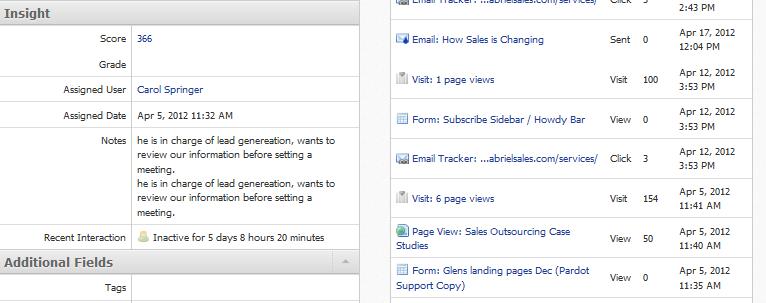
Your success as a marketer, business unit manager or small business owner depends on your ability to help the sales team sell. Ask yourself these questions:
- What if your competitors demand generation engine could tell your sales reps what each prospect is interested before and during the entire sales process?
- What if your competitor gave their sales reps tools so they could send the right content and track that content as the buyer was buying?
- What if your competitors delivery team blogged once a week with their thought leadership and points of view to help your their sales reps address objections?
Who is going to win that deal?
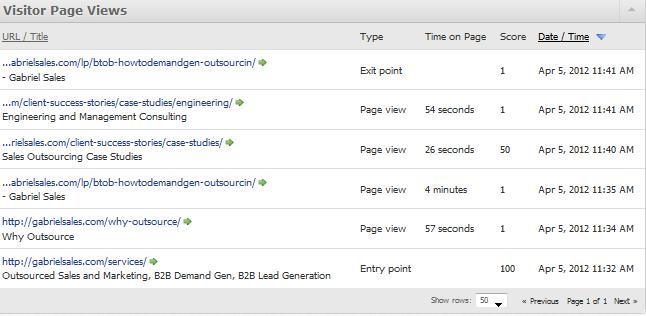
If any of the thought we are sharing hit a chord or to see if Sales and Marketing Outsourcing or some Sales and Marketing Process Consulting may be able to help you accelerate your B2B Demand Generation Engine please feel free to contact us for a free benchmark and 30 minute needs analysis.
Related Blog Posts:
Top 10 Strategies for B to B Demand Generation
How to Align Your Sales and Marketing Process
by gabriel_sales | Apr 26, 2012
Working Every Lead Critical in Business to Business Sales – Tip from Marketing Outsourced Company
As a business to business sales outsourced sales and marketing company we work at accelerating B2B sales for the Fortune 1000 and small businesses. The fundamental difference between the two types of companies is the volume of leads they can generate for their sales reps. As a small business we guarantee that you cannot compete against the big boys if you do not adopt the principal that you need to Work Every Lead. Adopting the philosophy that you need to “Work Every Lead” will guarantee that you maximize the sales pipeline from your leads and we can almost guarantee that the Fortune 1000 has a team that’s sole function is to qualify leads for their sales reps. This function is one major advantage a sales and marketing outsourced company can provide.
We also recommend that this team reports directly to the sales head or the small business owner. Often referred to as the demand generation team this group needs to be held responsible for sales qualified leads they put in the pipe. This group should leverage a marketing automation platform to keep both them and the sales reps accountable, to meet your companies hard revenue goals, and that all progress is communicated in a structured way.
Working every lead will ensure that your company is:
- Responsive: There are numerous studies that show that a quick response leads to higher conversion rates.
- Professional: A company that engages with a lead that does not turn into an opportunity can still gain from a prospect’s positive experience. These can lead to referrals, which are very powerful in today’s socially connected world.
- Learning: The sales demand generation team is now a great source of feedback to the demand generation teams on the effectiveness of programs.
- Efficient: This structure will ensure that your company gets the best ROI on your program dollars, when measured in pipe to spend, or a close to spend type metrics.
It’s up to the sales leader to be the champion of this process and to create the proper environment for this success. Ready to get started…feel free to contact us for a free benchmark and 30 minute needs analysis.
Related Blog Posts:
Top 10 Strategies for B to B Demand Generation
How to Align Your Sales and Marketing Process
by gabriel_sales | Apr 25, 2012
As a B2B outsourced sales company and B2B sales marketing company we have watched the typical sales cycle go through some radical gyrations over the past year. In some cases your buyers are now buying more quickly as they reach out just in time to make a decision after budget is approved, as they are quickly shortlisting and making a decision in less than 60 days. About 20% of your buyers (according to Sirius Decisions and what we have seen from our Marketing Automation Platform) are reaching out and essentially placing an order for smaller transactions. There are still buyers buying via relationships and you also have buyers that are taking a much longer time to research and explore their options prior to the making a decision and this extends the sales cycle. Bottom Line you have buyers that are now buying in a much less predictable and much more fractured way. This means you need to have a strong cold calling, strong inbound and strong content marketing program in place or you will lose between 10%-20% of the revenue you used to take for granted to a competitor that is selling to that particular buyer the way that buyer wants to buy. Below is a quick overview of the shortest path to meeting the needs of this now fractured market.
Marketing Automation Implementation
From our perspective as a B2B outsourced sales and B2B Sales Company the first step in being able to address these new challenges we all face is to strongly consider a Marketing Automation Software. A marketing automation solution brings significant advantages in terms of increasing the productivity of your sales demand generation across a wide variety of buying cycles. Marketer can now generate, score and nurture leads to a level that was not possible just a few years ago and in some cases for smaller businesses we are able to help implement solutions with some of our proprietary tools that allows you to eliminate marketing as a function and put these demand generation tools into the hands of your sales reps for decreased costs and increased productivity.
In fact the number one reason we have seen companies fail to convert these breakthrough technologies into success is because they are not letting sales professionals drive the implementation of the solution. The reason that many companies fail to exploit their demand generation success is that they fail to implement the key events of a sales persons proven sales process into their demand generation process.
Lead Scoring
Probably the biggest efficiency gain you can get from a marketing automation tool is its ability to score leads so your sales reps are focusing their phone time on the buyers most likely to buy. The lead scoring and nurturing features of these tools ensure that your company can manage the top of the funnel through to marketing qualified leads (MQL) with limited interaction with the sales reps. Marketing Automation Software allows you to observe and score the content your prospects are digesting online and in email follow ups. Once a lead has indicated (through the way they have navigated your content and digested information) that they are ready to buy your lead generation reps can prioritize that lead and take them through the final qualification steps with some human contact to move them to a Sales Qualified Lead (SQL) and into the pipeline.
Dedicated Demand Gen Team
The key to achieving a process that puts more Sales Qualified Leads into your sales reps pipe is to create a dedicated team that takes the MQLs and converts them to SQLs. Many companies try to short cycle this by having the sales teams do this job. This does lead to pipeline and closed business this quarter but this has a cost to the long term value of your pipe. You will land the 20% that are buying quickly but what happens to the rest of your revenue? It goes away and the reason for this is simple; sales people will take the shortest route to solving their needs and will cherry pick the good leads and leave the others. Why spend thousands on demand generation programs, only to have your company waste the investment, due to lack of rigor?
If you would like to learn more about how a sales marketing company can help you align your inbound and outbound efforts for a fatter pipe and more closed revenue please feel free to CONTACT US for a free initial strategy conversation.
If you are having cultural issues between sales and marketing we suggest you check out B to B Demand Generation Requires Sales and Marketing Alignment. You can also checkout our Free White Paper on 10 Tips and What to Avoid to Sell Smarter and Faster.




 Organize your Content Ahead of Time
Organize your Content Ahead of Time 

